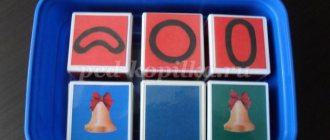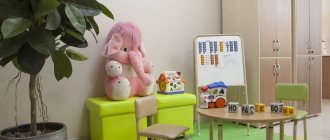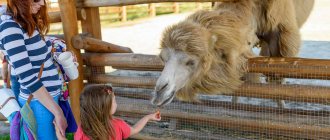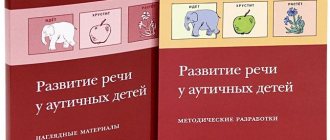Topic: “Sounds [Zh] and [Sh] and letters Zh, Sh”
Download lesson notes
Tasks:
Corrective and developmental:
- consolidate children's knowledge of consonant sounds and letters SH-Zh;
- introduce children to the comparative characteristics of the sounds [SH] [Zh], the norms of their articulation;
- learn to identify sounds [zh], [w] in words, phrases and sentences, relate sounds to letters and symbols;
Educational:
- develop skills in sound-letter analysis and synthesis;
- form voluntary auditory and visual perception, attention and memory;
- develop vocabulary in expressive speech on the lexical topic: “Winter sports.”
- develop the ability to compose phrases, consolidate knowledge of spelling norms;
- form grammatical stereotypes of word formation in expressive speech;
Educational:
- develop self-control skills;
- cultivate a sense of pride in one’s homeland;
- improve the ability to evaluate the results of work on a task;
- cultivate a culture of behavior during front-line work and individual work;
- develop the ability to listen and hear each other, work in a team;
- cultivate a polite attitude towards a friend.
Basic concepts: Winter Olympic Games, winter sports, Snow leopard - symbol, symbol of the Olympics - Olympic rings.
Methods and methodological techniques:
Methods: productive and reproductive, partially exploratory, visual, problem posing, finding a solution, leading dialogue, encouraging the formulation and testing of hypotheses, control and self-control method.
Techniques: activation of attention, motivating technique, game.
Forms of work : frontal work, individual work.
Equipment : board, video projector, computer, multimedia presentation, workbooks, pencils, pens, individual cards.
Presentation for the lesson “Sounds [Zh] and [Sh] and letters Zh, Sh”
Smetanina Galina Valentinovna, teacher-speech therapist, MBOU primary school-kindergarten No. 37, Surgut
- Speech therapy lesson summary: Vowel sounds and letters
- Summary of an individual speech therapy lesson: Sounds and letters R, L, automation in syllables, words
- Summary of an individual speech therapy lesson in grade 2 “I-U differentiation”
- Summary of speech therapy lesson in 1st grade “Dividing words into syllables”
- Summary of speech therapy lesson in 1st grade “Differentiation of sounds [L] - [L']“
( 3 liked, average score: 5.00 out of 5)
Loading...
self-analysis of a speech therapy lesson; methodological development (speech therapy, senior group) on the topic
Introspection
open individual speech therapy session
Speech therapist: Pavlova E.V. February 2014
Topic: “Sound [L]. Automation stage. "Animals"
The lesson was conducted with a child diagnosed with FFND. A lesson on the topic of automation of sound [l] in syllables, words, sentences, in text. The lesson occupies an important place in the system of lessons on the topic being studied, and is organized in accordance with a long-term plan for individual correctional and developmental work.
The following goal was set during the lesson: to automate the sound l in syllables, words, sentences, and text.
The following tasks were set during the lesson:
1. Educational: to consolidate knowledge about the mechanism of sound formation, its acoustic features, to develop the ability to construct a coherent statement when analyzing sound, to consolidate vocabulary on the topic “Animals”, to form endings of nouns in indirect cases)
2. Correctional: develop gross and fine motor skills, develop facial muscles, build strength by the force and duration of exhalation, develop mobility of the articulatory apparatus, form kinesthetic sensations and correct articulatory movements for a given structure, develop the ability to analyze sound articulation, develop phonemic hearing, form skills sound analysis and synthesis based on graphic recording, consolidate correct pronunciation in syllables, words, sentences, texts, develop attention and memory.
3. Educational: cultivate love for animals, cultivate perseverance, and the ability to concentrate on a task.
The goal and objectives are set in accordance with the content of the lesson. The goals were achieved in unity with correctional and developmental, educational and educational tasks. Solving problems is achieved by various methods and techniques: verbal, visual, practical.
The main stages are built sequentially and are interconnected. There was a transition from one stage to another. Each stage of the lesson prepared the children for subsequent work. The time between each stage of the lesson is distributed expediently, in accordance with the child’s capabilities and the objectives of the lesson. The lesson lasted no more than 20 minutes
All material is in accordance with the speech and age characteristics of the child. Speech material corresponds to the goals and objectives of the lesson. Practical, visual, and verbal methods of work were used during the lesson. The following didactic principles were taken into account: the principle of visualization of learning, the principle of consciousness and activity of learning, the principle of accessibility of communicated knowledge, the principle of a differentiated and individual approach. All these principles were implemented in the lesson.
The lesson included an exercise for the development of speech exhalation, an exercise for the development of general and fine motor skills, articulatory motor skills, as well as an exercise for the development of facial expressions, the emotional-volitional sphere, and the development of voice strength. The speech material was selected taking into account the child’s capabilities, level of speech development, and age characteristics. Work was carried out to develop skills in sound analysis and synthesis, and the formation of case endings for the dative case of nouns. Development of coherent speech based on the lexical topic: “Animals.”
During the lesson the child worked actively. The result was achieved.
Self-analysis of classes in the preparatory group
On the theme “Autumn. Trees. Getting to know the sound [I]"
Speech therapy topic: Sound [and]
Grammar topic: Formation of qualitative and possessive adjectives
Lexical topic: Autumn. Trees. When planning the lesson, the following goals were set: correctional-educational, correctional-developmental, correctional-educational goals.
Correctional and educational:
1. Cultivating attention to the sound side of speech, the formation of phonemic perception:
- clarification of the correct pronunciation of the sound: [and]
- development of articulatory motor skills;
- auditory discrimination of studied vowels;
- isolating a vowel sound from the beginning and end of a word in the stressed position of the sound [and];
- isolating the vowel sound [i] from the composition of the word in the stressed position;
- developing the ability to characterize sound;
- formation of concepts: vowel sound.
2. Consolidation of knowledge about trees (names of trees, their structure, external signs; ability to distinguish trees by external signs).
3. Raising attention to changes in the grammatical forms of words, methods of word formation and the formation of grammatical means of the language and word formation skills:
- formation of singular and plural present tense verbs (yellowed, fallen, swirled);
- formation of possessive adjectives (oak leaves);
- formation of qualitative adjectives (Cold, windy, warm, sunny, cloudy, gray, boring, sad)
- formation of complex words (leaf fall);
- drawing attention to the polysemy of words (needle);
- formation of words with diminutive - affectionate suffixes (leaf - leaf, leaf, tree - sapling, birch - birch tree, fir tree - fir tree, oak - oak tree).
4. Development of the prosodic side of speech.
5. Development of mental processes: auditory and visual perception, memory, attention; formation of mental operations (skills of analysis, synthesis, comparison, generalization).
Correctional and developmental: develop auditory attention and memory, articulatory, fine and gross motor skills, coordination of speech with movement.
Correctional and educational: developing skills of cooperation, mutual understanding, goodwill, independence, initiative, responsibility. Fostering love and respect for nature.
The entire lesson was structured taking into account the requirements of the Federal State Educational Standard:
the structure of material and technical support reflected the specific requirements for the organization of space (I used an equipped speech therapy room), the organization of a temporary training regime - the lesson was held in the morning, the use of TSO and ensuring comfortable access for children with severe speech impairments to education, special educational and didactic materials that meet educational needs - I used the following equipment: a computer, a magnetic board, demonstration material (pictures depicting different trees and leaves, pictures depicting a hedgehog, a spruce branch, a needle), natural material in the form of dried tree leaves, speech therapy aid Tsukanova SP., Betz L.L. “Teaching a child to speak and read.”
The lesson carried the maximum load, was structured taking into account psychophysiological individual characteristics, and had connections with all educational areas:
- social and communicative development (development of communication and interaction of the child with the teacher - speech therapist, peers, formation of a positive attitude towards the lesson;
- cognitive development (acquaintance and assimilation of new material.);
- speech development (answering questions, reasoning);
- artistic and aesthetic development (acquaintance with the works of A.N. Pleshcheev, P.I. Tchaikovsky);
- physical development (physical exercises, finger gymnastics).
All this had a positive impact on children’s activities (learning to read and write, developing grammatical categories).
The goals of the lesson were realized through the following methods: demonstration, a series of questions (supporting, clarifying, searching, pronouncing answers - individually, in chorus, motivation (say it correctly, etc.). The content of the children’s activities in the lesson corresponded to the goals, the tasks were arranged in an increasing order difficulties.
The organizational moment helped to concentrate the children’s attention and activate in their memory previously acquired knowledge on the lexical topic “Autumn”, “Trees”. Speech classes are always difficult for children; many concepts are abstract for children. To achieve optimal results from the lesson, I introduced techniques that increase motivation (surprises from Autumn). In a speech therapy lesson, it is necessary to maintain a clear structure of construction, each part of the lesson fulfills its specific purpose.
In the lesson, I selected tasks for the formation of lexical and grammatical categories and the development of coherent speech, which meets the requirements for correctional classes. Reliance on play as the leading activity of preschoolers and the mandatory inclusion of various types of games in speech therapy classes provided a pronounced positive effect both in overcoming speech disorders and in the development of cognitive mental processes. (d/i “Collect a picture”, d/i “Which tree is the leaf from?”, breathing exercise “Blow a leaf away”, d/i “Guess the riddle and identify the first sound in the answer”). The emotional mood was ensured by entertaining game techniques, imagery and colorfulness of the material, as well as a trusting relationship between the speech therapist and children, the creation of a situation of success in weak children, encouragement, and psychological comfort in the child’s soul.
The lesson took place with a change of activities (at tables, at the blackboard, on the carpet), the children were completely immersed in the atmosphere of entertaining tasks and performed them with particular interest. Throughout the lesson, the following forms of children's activity were used: individual, subgroup.
Individual tasks (work in individual albums) made it possible to identify the degree of mastery of the material by each child; frontal work was provided by the subgroup.
Personally-oriented interaction with children (listening to the opinion of each child, supporting their reasoning with a positive assessment) helped create a situation of success for each of them. During the lesson, the following mental processes were activated: auditory attention in working on word formation and composing sentences; logical thinking, visual perception (through cut-out pictures). As a necessary element of a speech therapy lesson, I used tasks for the development of fine motor skills (picture collection).
An entertaining physical activity provided relaxation and a change of actions, but at the same time activated the children for further work. In the final part of the lesson, the results of the lesson were summed up and a positive assessment was given of the activities of each child in the lesson, which had a psycho-emotional orientation.
The result obtained confirmed the effectiveness of the methods and techniques I selected for teaching children literacy and the formation of grammatical categories, and taking into account the results of the lesson will help monitor the progress of further learning, establish feedback, and allow us to outline ways for further work with children, both in classes and in other activities .
MU “Rehabilitation Center for Children and Adolescents with Disabilities “Tredi” Department of Social Rehabilitation. Author of the material: Boytseva Irina Gennadievna
Also on topic:
Lesson summary on teaching literacy in preparatory class V type. Theme: “Sound and letter s”. Self-analysis of the lesson
Self-analysis individual speech therapy session based on the fairy tale by K. I. Chukovsky “The Tsokotukha Fly”
Self-analysis of an individual speech therapy session
The date of the: 22.01.2016
City (district) MBOU "Education Center No. 57"
Lesson form ( individual
) Topic
“
On the lexical topic
“Automation of the sound [zh] in syllables, words and phrasal speech (based on the fairy tale by K. Chukovsky “The Tsokotuha Fly” )
Age, number of children:
1 child of the preparatory group.
Speech therapy conclusion
ONR III level
Purpose
– consolidation of the correct pronunciation of the sound [zh] in isolation, in syllables, words and pure phrases.”
Tasks:
Correctional and educational:
- Develop the ability to form adjectives from nouns.
- Develop syllable reading skills.
- Cultivate perseverance and accuracy Correctional and developmental:
- Develop fine motor skills of the fingers.
- Develop articulatory motor skills.
- Develop phonemic awareness.
- Develop visual and phonemic perception, attention.
- Strengthen the skill of sound automation [zh] in syllables, words, and phrases.
- Develop the skill of syllabic analysis.
Correctional and educational:
- Cultivate moral qualities: kindness, responsiveness.
- Cultivate perseverance, respect for nature, and feelings of empathy.
- Foster independence in work, initiative, responsibility
The lesson was conducted with a child with ODD level III and corresponded to the plan of correctional work and the requirements of the program by T. B. Filicheva, G. V. Chirkina for children with ODD, taking into account the recommendations of the approximate basic general education program of preschool education “From birth to school”, ed. N. E. Veraksy, T. S. Komarova, M. A. Vasilyeva. Goals and objectives correspond to the targets of the Federal State Educational Standard for Education. The speech material corresponds to the goals and topic of the lesson, which is structured logically and consistently.
The goals were achieved through solving a number of tasks: developmental, educational, educational and health-improving. was communicated to the child, was understandable to him and corresponded to the content of the lesson. The selected methods and techniques corresponded to his age and were selected taking into account his individual characteristics (state of attention, degree of fatigue, etc.). Visual and verbal instructions were presented accurately and clearly. The following assistance was used: attracting attention, stimulating verbal and mental activity through demonstration, joint activities, using questions of different types (direct, leading, prompting, using visual supports (presentation slides). The stages of the lesson were interconnected and sequential.
The structure of the GCD is built from the following elements: organizational moment - guessing the riddle, which was the goal of the lesson; creating conditions for solving the problem; in order to develop speech motor skills and prepare the child’s speech apparatus, articulation gymnastics was carried out (using a presentation). In order to prevent fatigue, fun finger exercises and physical exercises were carried out, which help relieve fatigue and develop fine motor skills; consolidation and generalization of the child’s knowledge in a playful way; outcome, where children achieve their goals.
To implement tasks during educational activities, I used various pedagogical technologies: electronic educational resources, ICT, gaming and health-saving technologies.
- She interested the child by creating conditions for the emergence of motivation for new activities: the presence of a surprise moment - riddles, viewing a presentation and completing an article for hissing ones, listening to the audio fairy tale “The Fly-Tsokotukha”, didactic games “Find the Letter”, “Buzzer Houses”; object pictures (words with sound [zh]).
2. Organization of GCD:
a) during the lesson, sanitary and hygienic requirements were observed, the alternation of activities, the focus on maintaining the child’s posture, the duration of the lesson, air thermal conditions, lighting;
b) the structure and content of the lesson correspond to the proposed topic, meets the goals and objectives, and corresponds to the age characteristics of the child;
c) in NOD several methods of educational activities were used: visual (showing art/g actions, looking at subject pictures, slides); verbal: teacher’s story, questions, reasoning, conversation; gaming: didactic games “Find the letter”, “Buzzer Houses”; practical: drawing (drawing lines)
d) modern technologies were used in GCD: ICT (viewing slides, listening to audio); gaming (active game, surprise moment-riddles);
e) all types of educational areas were implemented in GCD: social and communicative development (communication and interaction of a child with an adult, development of independence, development of emotional responsiveness); speech development (development of coherent speech, analysis and synthesis, enrichment of active vocabulary); cognitive development (development of ideas about insects); artistic and aesthetic development (perception of audio recordings, fiction, implementation of independent activities); physical development (articulation and finger gymnastics, logorhythmics);
f) throughout the entire lesson, there was a gradual change in types of activities, which made it possible to maintain a positive emotional mood in the child (practical, communicative, gaming);
g) throughout the entire lesson, the child was actively involved in the activity, answered questions with interest, participated in conversations, and completed tasks;
h) during the lesson, I called the child by name, gave him the opportunity to speak, listened to the answers to the end, observing etiquette in communicating with the child. During the lesson, I used knowledge about the individual emotional characteristics of the child, which helped to implement an individual approach. This was manifested in the fact that tasks of varying degrees of difficulty were accompanied by comments, and sometimes “advance” praise and support;
f) the speech material is selected and presented in an accessible form, although quite difficult words and complex tasks were taken, which in turn indicates the implementation of the development principle;
j) throughout the entire lesson, the child maintained a positive emotional mood, I used a verbal system of encouragement for the girl, following the playful motivation, interest in the result was maintained throughout the lesson;
4. At the end of the lesson, I conducted an analysis of the lesson and reflection (the girl listened with great pleasure to the audio fairy tale “The Cluttering Fly”).
During the NOD, the following objectives were achieved: developmental; (development of coherent speech, logical thinking, visual attention, phonemic processes, cognitive interest); educational; (the ability to correctly answer questions, perform exercises, reinforced the way to correctly hold a pencil when drawing lines); educational; (raised positive attitudes towards insects, emotional perception of fairy tales).
5. During the lesson, the girl was active, interested, with a positive emotional attitude, showed a positive attitude towards the result of the activity, and tried to complete tasks carefully and correctly.
I think the lesson was very intense, a large amount of work was done, the tasks completed showed that the goals of the lesson were achieved.







